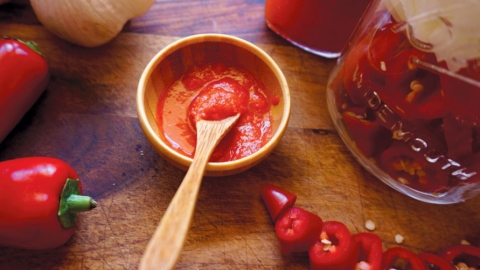Ingredients
- 1 quart-size, wide-mouth Mason jar with lid
- 1 4-ounce Mason jar
- 2 cups water, room temperature (spring water is best; just make sure it’s chlorine-free, as chlorine could prevent fermentation)
- 1 tablespoon mineral salt, such as Himalayan or Celtic
- 1 medium-size white or yellow onion, peeled
- 4 cloves garlic, peeled
- 1½ cups chili peppers, preferably organic or farmed sustainably
Preparation
Before starting any fermenting project, make sure your cooking area, tools and containers are very clean.
Make a brine with the 2 cups spring water and 1 tablespoon mineral salt. Stir until salt has dissolved. Set aside.
Gently wash onion, peppers and garlic using a mild dish soap like Mrs. Meyer’s brand, or soak in equal parts distilled vinegar and water. Rinse well and dry ingredients.
Chop onion. Wearing gloves to protect your hands, slice peppers, leaving seeds, and discarding stem. (Whole peppers also can be fermented.) Put peppers, onions and garlic in quart-size Mason jar; pour in brine solution. Make sure ingredients are completely submerged.
Fermentation is an anaerobic process. For the beneficial microorganisms to thrive, the vegetables can’t be in contact with oxygen. To press down the vegetables and keep them submerged in the brine, place the 4-ounce Mason jar into the large jar on top of the mixture.
Tightly seal quart-size, wide-mouth Mason jab with metal lid and ring to prevent introduction of airborne contaminates. Place a plate or tray under Mason jar—just in case juices overflow. Leave to ferment for 1 to 3 weeks in a dark location that has no drafts. (The longer you ferment, the more diverse, gut-healthy probiotics will grow.)
For the first week, check every day to see if the metal lid on the jar is bulging. If it is, release carbon dioxide buildup by gently loosening jar’s lid. (This is a sure sign fermentation is taking place.) Let juices flow into sink. (Keeping an airtight vessel is one of the keys to a successful batch, so add more brine if the veggies are no longer fully submerged.) Retighten lid and return to dark location.
After fermentation is complete, take off lid—it’s OK if the mixture bubbles. Remove small Mason jar, strain mixture into a bowl and reserve brine. Transfer fermented ingredients to a food processor or blender. Add ½ cup reserved brine and blend for about 30 seconds (or longer for a smoother consistency). Add more liquid a little at a time until hot sauce reaches desired consistency.
Transfer to an airtight jar and store in the refrigerator. Hot sauce is now a preserved living food and will keep for many months, if not years.





